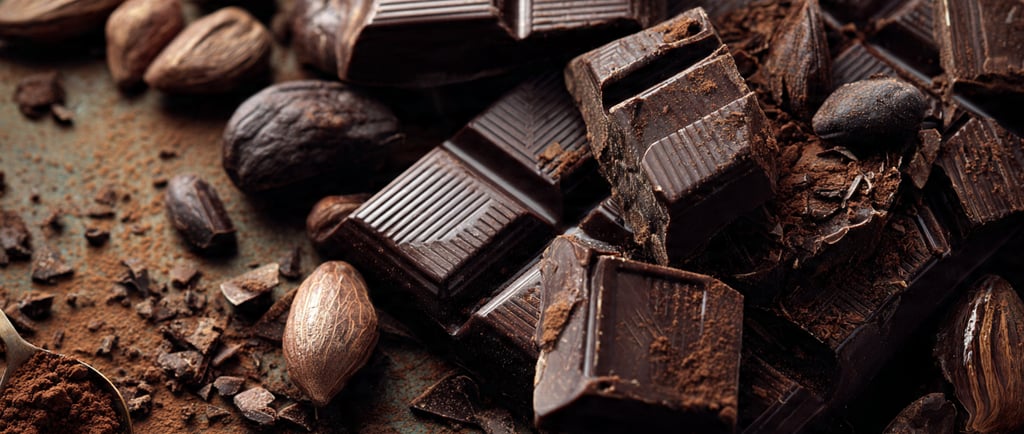Beyond Sweetness
The Science of Why Chocolate Tastes the Way It Does


For all its universal appeal, chocolate is one of the most complex foods on Earth. A single bar may contain more than 600 identifiable aroma compounds—more than red wine, more than coffee, more even than many whiskies. And the astonishing part is this: cacao beans do not naturally taste like chocolate at all. Every flavor we recognize—from raspberries and hazelnuts to caramel, honey, smoke, or spices—comes from a series of transformations as old as civilization and as intricate as perfumery.
Why does one chocolate bar taste like bright citrus, while another tastes like toasted walnuts or cherries soaked in wine? Why do some chocolates feel smooth and sweet while others hit with sharp acidity or deep bitterness? The answers lie in a surprising mix of genetics, chemistry, climate, and even human psychology.
This is the story of how chocolate earns its flavor—and why no two bars, even from the same farm, ever taste exactly alike.
I. It Begins in the Tree: Terroir and Cacao’s Genetic Personality
Just as grape varietals shape a wine’s profile, cacao genetics dictate a huge part of chocolate’s flavor. Criollo tends to be delicate and nuanced; Trinitario often expresses fruitiness; Forastero offers deep cocoa tones and strength. But genetics are only the start.
Terroir—the taste of place—plays a profound role:
Soil composition adds minerality or depth.
Rainfall and drought cycles influence sweetness or acidity.
Shade level changes bean development.
Altitude affects the pace of ripening and the concentration of flavor compounds.
A cacao tree growing 200 yards away from another—different slope, different humidity pocket—may produce beans with surprisingly different notes.
In this early stage, flavor is potential energy. Everything that comes later will develop it, brighten it, or completely transform it.
II. Fermentation: The First Wave of Flavor Formation
Fermentation doesn’t just prepare cacao—it creates chocolate flavor.
Different microbial communities contribute different sensory signatures:
Yeasts introduce fruity and floral notes.
Lactic acid bacteria create yogurt-like tang and sweetness.
Acetic acid bacteria build chocolate’s sharp, bright backbone.
Environmental microbes unique to a village or valley create hyper-local flavor.
A tropical valley in Belize may yield chocolate reminiscent of pineapple. A remote farm in Peru may produce beans that lean toward herbs or purple fruit.
Fermentation is chocolate’s first major flavor “accent.”
III. Drying: When Flavor Gets Concentrated or Lost
Most consumers never think about drying, but it may make or break a chocolate.
Too fast, and beans taste papery or raw.
Too slow, and they risk mold or muddy off-notes.
Too smoky, and they absorb wood-fire aromas from drying huts.
In direct sun, they develop brighter acidity.
In shade, they gain mellow, sweeter characteristics.
Drying isn’t preservation. It’s flavor sculpting.
IV. Roasting: The Great Transformation
Roasting is the only step that can completely rewrite a bean’s future.
Chemists call it the Maillard Reaction, the same process that browns bread crusts and sears steaks. But in chocolate, the reaction is far more layered.
Roasting can create:
Hazelnut
Honey
Toffee
Dark cherry
Tobacco
Malt
Floral vapors
Warm spices
Vanilla-like aromatics
And depending on the roaster’s choice, these flavors may emerge subtly—or boldly.
V. Conching: The Step That Most People Never Hear About
If roasting gives chocolate flavor, conching gives it voice.
Conching (mixing warm liquid chocolate for hours or even days) does three major things:
Smooths texture into the silkiness we associate with fine chocolate.
Evaporates undesirable acidity, balancing brightness.
Refines aromatics, creating harmony between flavor notes.
A short conch yields chocolate that tastes wild, bright, and punchy.
A long conch creates chocolate that tastes elegant, rounded, and soft.
Think of it like music: conching turns individual instruments into a symphony.
VI. Why Humans Taste Chocolate Differently
Flavor is only half chemistry—the other half is psychology.
Our brains interpret chocolate through a blend of:
Smell (80% of flavor perception)
Temperature (warmer chocolate tastes sweeter)
Texture (smoothness boosts perceived richness)
Memory (associations with childhood chocolate influence flavor interpretation)
Cultural expectation (some cultures prefer acidic chocolate, others prefer mellow)
Two people tasting the same bar will often describe radically different notes—both are correct, because flavor is personal architecture.
Even mood changes the experience: the same bar tastes different when you’re tired, stressed, or joyful.
VII. The Surprising Role of Sugar, Milk, and Salt
While purists focus on cacao, add-ins shape flavor dramatically.
Sugar highlights fruitiness at certain ratios and cancels bitterness at others.\
Milk powders (caramelized, whole, or skim) add toffee or malt notes.
Salt intensifies both sweetness and complexity—even in tiny amounts.
Cocoa butter additions lighten the flavor, making delicate notes easier to detect.
The recipe determines how chocolate “speaks.”
VIII. Why No Two Bars Ever Taste Exactly the Same
Even with identical genetics, fermentation, roasting, and conching, chocolate remains unpredictable. Weather shifts, soil cycles, aging of equipment, and even small microbial variations create yearly “vintages”—just like wine.
This is why true chocolate professionals talk about harvest profiles, not just flavor notes.
Chocolate is agriculture, not manufacturing. Each batch carries the fingerprint of nature.
IX. The Real Joy of Chocolate Tasting
When you taste chocolate:
Let it melt slowly.
Breathe in through your nose as it melts.
Notice the first flavor, the middle evolution, and the finish.
Pay attention to acidity, sweetness, bitterness, aroma, and mouthfeel.
Look for fruit, nuts, florals, spices, wood, or earthy undertones.
Chocolate is a landscape of shifting impressions, shaped by science but felt emotionally. Its complexity is a reminder that nature and craft, working together, can produce something astonishingly multidimensional.
Contact
info@menloparkchocolatecompany.com
© 2025 Menlo Park Chocolate Company. All rights reserved.
Subscribe to receive special offers and to hear about new product drops!
